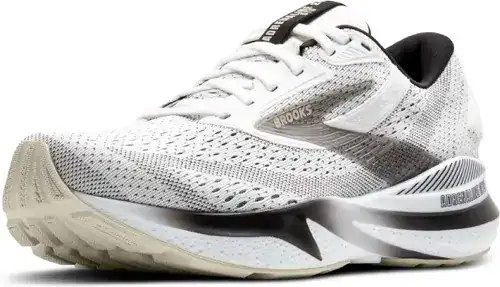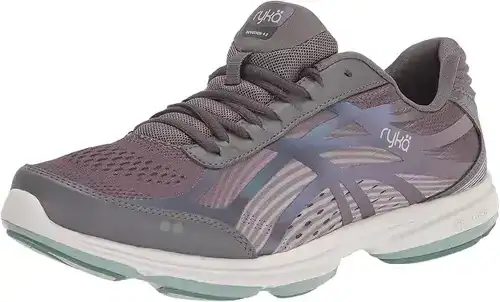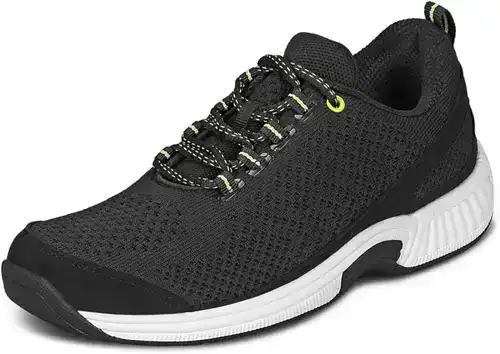Last Updated on June 23, 2025 by Andy Walker
As a running coach, I’ve seen firsthand how the wrong pair of shoes can aggravate knee pain—or even cause it. Many runners assume their form or mileage is to blame, but often it starts from the ground up. Proper footwear can help realign your stride, stabilize overpronation, and provide the shock absorption your knees desperately need. Whether you’re getting back into training or just need supportive shoes for daily walks, investing in the right pair makes a huge difference. The shoes reviewed below are the models I most often recommend to my clients dealing with knee discomfort.
Our Top Pick:
ASICS Gel-Kayano 32
Trusted by coaches for a reason—this stability shoe delivers cushioning that reduces impact and improves alignment.
Be sure to also see our buyer’s guide for tips on picking the right shoe for you
Summary: Best Shoes for Knee Pain
Shoe Model | Best For | How It Helps | Price |
|---|---|---|---|
Runners with overpronation or knee pain | 4D Guidance System, PureGel heel, and FF BLAST PLUS cushioning reduce impact and improve alignment | ||
Daily runners needing balance and support | GuideRails tech and DNA Loft midsole maintain proper form and comfort over long distances | ||
High-arch, neutral runners seeking plush ride | Maximalist DNA Loft cushioning helps absorb shock and reduce stress on knees | ||
Women walkers with knee pain or sensitive joints | Lightweight, breathable upper and responsive cushioning reduce walking impact | ||
People needing orthopedic support for foot, knee, and back pain | Orthotic footbed, arch support, and wide toe box minimize pressure and misalignment |
Detailed Shoe Reviews
Here are our reviews of the shoes we have selected as best shoes for knee pain.
ASICS Gel-Kayano 32
Best for: Overpronators needing structured stability

ASICS’ Gel-Kayano 32 continues to raise the bar for stability shoes. This version includes the new 4D Guidance System, which gently redirects stride misalignments without feeling intrusive. The FF BLAST PLUS foam midsole makes it noticeably lighter and more responsive than past iterations. A PureGel insert in the heel ensures smooth landings, ideal for runners with sensitive knees or recurring pain. Breathability and fit have also improved thanks to the engineered stretch mesh upper. As a coach, I recommend this for long runs and daily miles, especially for runners who want their shoe to do some of the alignment work. It’s ideal for moderate to severe overpronators. The ride is stable yet forgiving, though its slightly firmer feel may not suit those who prefer a plush step-in sensation.
See also: Asics Gel-Kayano models compared
Specs
- Stack height: 40mm heel / 32mm forefoot
- Drop: 8mm
- Weight: 10.5 oz (men), 9.0 oz (women)
- Cushion: FF BLAST PLUS + PureGel
Pros
- Highly stable platform
- Better energy return than earlier Kayano models
- Excellent durability
Cons
- On the firmer side
- Premium price point
Men’s version | Women’s version
Brooks Adrenaline GTS 24
Best for: Overpronators, flat-to-medium arches

The Brooks Adrenaline GTS 24 builds on over two decades of dependable design. As a running coach, I appreciate how it balances soft cushioning with firm stability. The biggest upgrade here is the nitrogen-infused DNA Loft v3 midsole, which offers a more responsive ride than past versions. Combined with co-molded GuideRails that help keep knees aligned, it’s one of the most forgiving options for runners dealing with overpronation and knee pain. The upper is breathable yet structured, and the wider base creates an inherently stable platform. It’s great for everyday training, walking, or standing on your feet for hours. While it leans slightly heavier than some neutral trainers, it offers a premium feel and long-haul comfort. Perfect for runners who need support but don’t want to sacrifice cushioning or comfort.
Specs
- Stack height: 37mm heel / 27mm forefoot
- Drop: 10mm
- Weight: 10.6 oz (men), 9.5 oz (women)
- Cushion: DNA Loft v3
Pros
- Smooth, stable ride
- Excellent arch and knee support
- Breathable, well-fitting upper
Cons
- Slightly heavy for tempo running
- Less responsive for speed work
Men’s version | Women’s version
Brooks Glycerin 22
Best for: High-arch, neutral runners wanting plush cushioning

Brooks Glycerin 22 is a top pick for runners seeking the most luxurious underfoot feel. Designed with DNA Loft foam throughout the midsole, it cushions every step—reducing stress on knees, hips, and joints. It’s best for neutral runners with medium to high arches who want max comfort without the bulk of a stability shoe. Though not as structured as the Adrenaline series, the Glycerin 22 features a smooth heel-to-toe transition and an internal stretch bootie that molds to the foot. It’s perfect for long runs, recovery days, or anyone standing for extended hours. While the soft foam can feel too mushy for speed workouts, it’s unbeatable for cushioning and joint protection.
Specs
- Stack height: Approx. 38mm heel / 28mm forefoot
- Drop: 10mm
- Weight: ~10 oz (men), ~9 oz (women)
- Cushion: Full-length DNA Loft
Pros
- Max cushioning for joint relief
- Smooth and quiet ride
- Excellent comfort for long runs
Cons
- Too soft for some
- Not suited for fast paces
Men’s version | Women’s version
Ryka Devotion Plus 3
Best for: Women walkers with knee pain or sensitive joints

The Devotion Plus 3 builds on its predecessor by enhancing the fit and cushioning—without raising the price. It’s crafted specifically for women’s foot biomechanics, featuring a wider forefoot and narrower heel for improved stability and stride alignment. Powered by RE‑ZORB cushioning, it absorbs shock effectively, easing pressure on knees and joints—something nurses, podiatrists, and walking enthusiasts all agree on. Early testers rave about its cloud‑like comfort, even praising its ability to counter foot, knee, and back fatigue during long shifts. While it may lack the durability of premium walking shoes, it’s a high‑value pick at around USD 70, offering thoughtful arch support and a breathable mesh upper. For women needing a supportive, budget‑friendly walking shoe to ease knee strain, the Plus 3 is a top contender.
Specs
- Material: Breathable mesh with synthetic overlays
- Midsole: Lightweight EVA + RE-ZORB cushioning
- Closure: Traditional lace-up
- Sizes: Women’s 5–12.5 (U.S.)
Pros
- Designed for women’s biomechanics
- Affordable and widely available
- Cushioned and breathable
Cons
- Not available in a men’s version
- Outsole may wear down with extended use
Orthofeet Plantar Fasciitis Shoes
Models: Orthofeet Coral for Women / Orthofeet Edgewater Men
Best for: People needing orthopedic support for foot, knee, and back pain


Orthofeet is a top-tier brand for orthopedic footwear, and its plantar fasciitis shoes are highly recommended by podiatrists and coaches alike for people suffering from chronic foot or knee issues. These shoes come with an orthotic insole that includes anatomical arch support and multiple cushioning layers. This setup cradles the foot, helping to alleviate pain from the heel all the way up to the knees and lower back. The wide toe box eases pressure on bunions and hammertoes, and the sole is both lightweight and designed to reduce joint strain. They’re not flashy or designed for performance athletes, but they’re ideal for daily wear, especially for older adults or those recovering from injury. The Edgewater is the men’s shoe and the Coral is the women’s shoe.
Specs
- Sole: Lightweight ergonomic rubber
- Insole: Orthotic with arch support and pillow cushioning
- Sizes: Men’s 7–14 | Women’s 5–12
- Special features: Wide widths, diabetic-friendly, 60-day trial
Pros
- Orthopedic-level arch and heel support
- Helps reduce pain across foot, knee, and back
- Generous return policy (60 days)
Cons
- Limited color selection
- Style leans medical, not sporty
Edgewater (Men) | Coral (Women)
Buyer’s Guide for Shoes that Help with Knee Pain
When knee pain interferes with your daily activities, the right pair of shoes can offer surprising relief. Supportive, well-cushioned footwear can help reduce joint strain, correct misalignment, and prevent further damage. This guide outlines the most important features to look for when buying shoes for knee pain.
Support and stability
Shoes that offer strong arch support and medial stability are essential, especially if you overpronate. Look for features like guide rails, dual-density midsoles, or structured heel counters that keep your stride aligned and reduce inward rolling of the foot.
Cushioning
Proper cushioning helps absorb impact and reduce stress on your knees. Midsoles made from shock-absorbing foam materials like EVA, DNA Loft, FF Blast, or RE-ZORB can soften landings and protect your joints. Look for shoes described as plush, cushioned, or responsive.
Heel-to-toe drop
The drop, or the difference in height between the heel and forefoot, can affect how much pressure is placed on your knees. A moderate drop (around 8 to 12 mm) works well for heel strikers, while lower drops (4 to 8 mm) may be better for forefoot strikers.
Fit and width
Shoes should fit snugly at the heel and offer enough room in the toe box for your toes to splay naturally. Poor fit can increase instability and make knee problems worse. Wide width options are worth exploring if standard sizes feel tight.
Gender-specific design
Some brands design shoes on gender-specific lasts that take anatomical differences into account. Women may benefit from a narrower heel, higher arch support, and lighter construction, while men often need a wider platform and more robust structure.
Final tip
If you’re dealing with chronic or recurring knee pain, shoes can be a big part of your solution—but they’re not the only one. A consultation with a healthcare provider can help you understand whether gait correction, orthotics, or physical therapy is also needed.